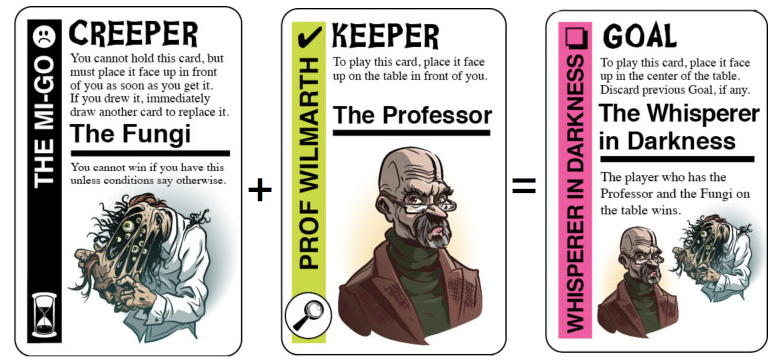
Note: culled from Cthulhu Fluxx: Guess That Goal.

In “The Whisperer in Darkness”, Professor Wilmarth visits an old friend who tells him about an astonishing tale about a race of aliens that have been visiting the Earth. We won’t spoil the ending, but you can read the story online.
From the beginning we wanted to make sure that Cthulhu Fluxx is fun and accessible, whether you’re a Lovecraft aficionado or a complete newcomer to his writings. If you examine the cards shown above, you’ll notice that each Keeper and Creeper has two different names. The horizontal name is a broad description—in this case, The Professor. That’s all you really need to know about this fellow; he’s an inquisitive academic. He might get in trouble when he investigates these fungi creatures. Perhaps he’ll team up with The Librarian to represent the school for the Miskatonic University goal. You don’t have to know any specifics; knowing he’s a Professor, you can hopefully guess how he connects to the other Keepers and Goals.
On the other hand, if you’re familiar with the stories the vertical name tells you exactly which character we’re thinking of: Professor Wilmarth from “The Whisperer in Darkness.” As a result, you can see just which stories have inspired us. And while Professor Wilmarth and Poet Edward Derby don’t share any goals, if you have these two Keepers you might be able to imagine how the student and Professor run into one another at Muskatonic U!
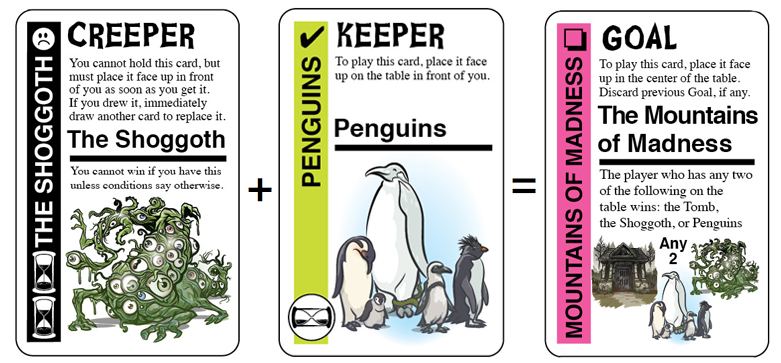
“At the Mountains of Madness” is the account of William Dyer, a Miskatonic Professor who relays the terrifying discoveries he made when his arctic expedition discovered an ancient city in the ice. We won’t spoil the ending, but there are worse things than penguins waiting in the darkness. You can read the story online.
First seen in Zombie Fluxx, Ungoals are the reverse of Goals. If the conditions of an Ungoal are met, everyone loses. Lovecraft’s stories often deal with mortals learning about the cosmic forces that threaten the Earth, and doing whatever they can to oppose them. However, in the stories these threats build over time, and we wanted to mirror that in the game. This is the point of Doom points – the symbol on the lower left corner of the Shoggoth. Most Ungoals require at least six Doom points to be on the table in order to trigger; there are also other effects that trigger off a player’s Doom total. While most Doom points come from creepers, there are also some Keepers that have Doom points on them. The Necronomicon is a very useful Keeper to have – but it has two Doom points. Do you dare play it?
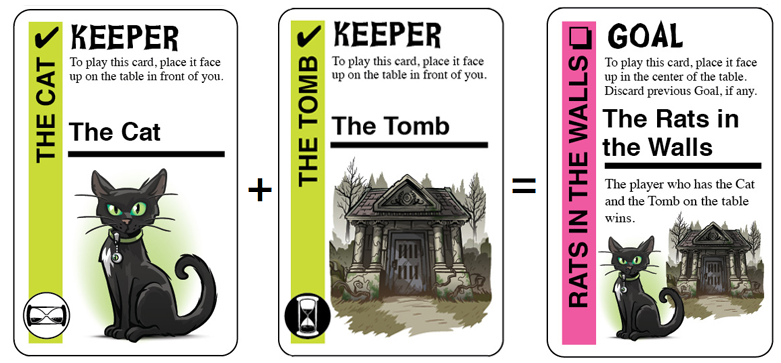
In “The Rats in the Walls”, a man and his unfortunately named cat hear strange sounds in his ancestral home. Are their truly rats in the walls, or does Exham Priory hold darker secrets? We won’t spoil the ending, but you can read the story online.
Last week I talked about Doom, the value that most Ungoals rely on. While most Creepers and a few Keepers carry Doom points, there are a few Keepers that have Anti-Doom points, which cancel out an equal number of Doom points. When you’re concern about the terrible things that may be lurking in your walls, your cat can be a comforting companion – and in addition to being able to bind Cthulhu, the Elder Sign helps to stabilize reality itself. On the other hand, if the Draw 2 + Doom Rule is on the table, you might be sad to have that darn cat getting in your way!
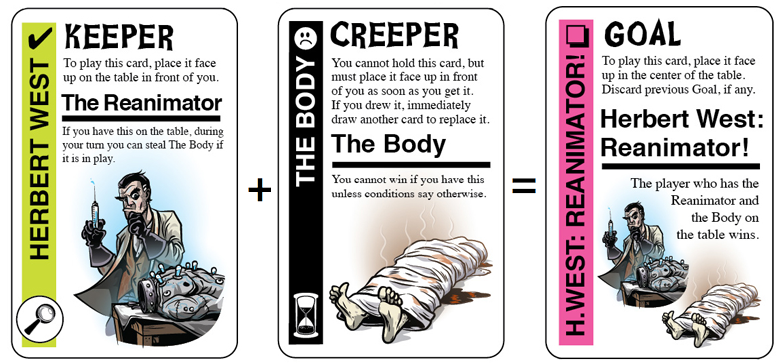
In “Herbert West: Reanimator”, A scientist works on a serum that can restore life to the dead. What consequences will this discovery have? Hint: they won’t be good. We won’t spoil the ending, but you can read the story online.
In previous weeks I’ve talked about the Doom and Anti-Doom symbols. There’s one more icon you can find in the lower corner: the Investigator symbol. Think of Investigators as the protagonists of the story – the people who are learning about the terrible things out in the darkness. Certain Goals can be achieved with any Investigator, and certain Creepers bond to Investigators; if the Reanimator continues with his studies, he might be plagued by Nightmares or even go Mad!
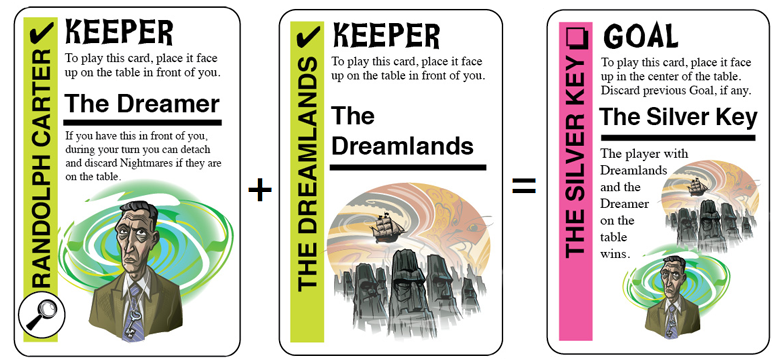
In “The Silver Key” Randolph Carter tries to recapture the wondrous dreams of his youth. We won’t spoil the ending, but you can read the story online!
The Dreamer Keeper in Cthulhu Fluxx is named Randolph Carter, and he has the power to face nightmares and triumph. We chose to give him the face of H.P. Lovecraft himself, for many consider Carter to be Lovecraft’s literary alter ego. He is man of good birth, a writer whose fantastic works have received little recognition, and a lover of cats. He is driven by his remarkable dreams, and the fantastic visions and adventures he has in those dreams. In particular, three stories deal with Randolph Carter’s exploration of dreams: “The Dream-Quest of Unknown Kadath”, “The Silver Key”, and “Through The Gates Of The Silver Key.” “The Dream-Quest” chronicles a fantastic adventure through the Dreamlands of Earth. By contrast, “The Silver Key” starts at a low point in Carter’s life, when the mundane elements of life have robbed him of his dreams:
He had read much of things as they are, and talked with too many people. Well-meaning philosophers had taught him to look into the logical relations of things, and analyse the processes which shaped his thoughts and fancies. Wonder had gone away, and he had forgotten that all life is only a set of pictures in the brain, among which there is no difference betwixt those born of real things and those born of inward dreamings, and no cause to value the one above the other.
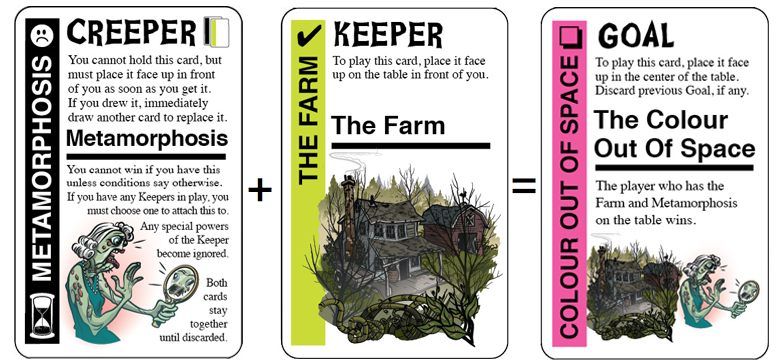
When a strange meteorite crashes near a New England farm, it exerts a disturbing influence on the lands around it. We won’t spoil the ending, but you can find the story online here!
Metamorphosis is one of three attaching Creepers in Cthulhu Fluxx. First introduced in Star Fluxx, an attaching Creeper bonds with a Keeper; whatever happens to one happens to the other. This mechanic is especially well suited to Cthulhu Fluxx, because transformation is a common theme in Lovecraft’s stories. Whether it is the physical metamorphosis of a place or person, or the mental transformation of being driven mad by the unnatural things that are uncovered, the idea of malign change is one I wanted to capture in the game, and the attaching Creeper is a great tool for this. Luckily, if one of your investigators does go mad, a quick trip to the Sanitarium will fix him right up!
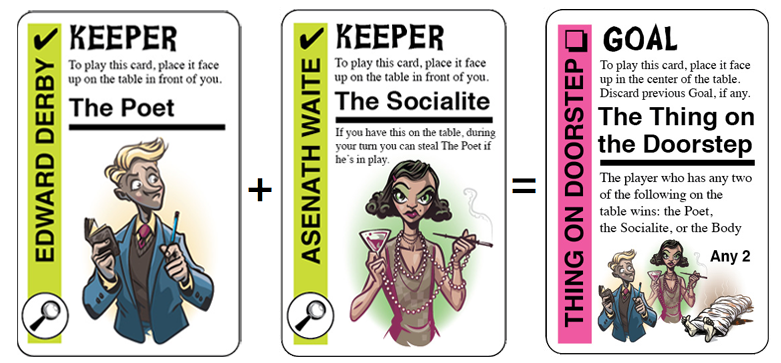
Young Edward Derby is taken with the lithesome yet loathsome Asenath Waite, an heiress from Innsmouth. What secrets lie in Asenath’s past, and how will they affect Edward and his friends? We won’t spoil the ending, but you can find the story online here!
When possible, I really wanted to have the Goals and Keepers actually reflect the action of the stories they represent. The Thing on the Doorstep is one of the best examples of this. The story begins with the Edward Derby falling under the spell of Asenath Waite, the seductive socialite – and this is reflected by the Socialite’s ability to steal the Poet from another player. Suffice to say that the story doesn’t end particularly well for Asenath or Edward. Thus, in having the Goal work with any two of the Poet, the Socialite, or the Body, it’s just a question of where in the story you stop!
While the Poet and the Socialite are drawn from this specific story, they match well to other goals as well. For example, Asenath is described as having a repellent aura common to the people of Innsmouth – so she also can be paired up with the Innsmouth Keeper for the goal The Innsmouth Look!
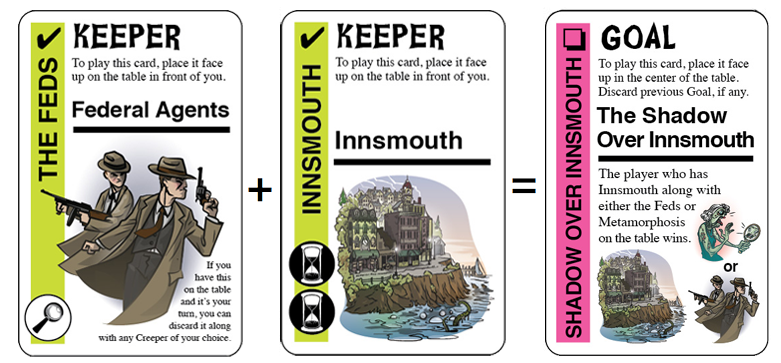
A young man sightseeing in New England stumbles across something ancient and strange in the decaying coastal town of Innsmouth – something so terrible it leads to an FBI raid! We won’t spoil the ending, but you can find the story online here!
As shown last week, a number of goals can be completed by having two of three Keepers. Like “The Thing on the Doorstep”, “The Shadow Over Innsmouth” reflects different aspects of the story. It’s set in Innsmouth, so you have to have Innsmouth on the table to complete it. However, your story could end with the FBI coming in to clean up the town… or it could end with one of your investigators undergoing a strange metamorphosis and finding that Innsmouth suddenly seems like home!
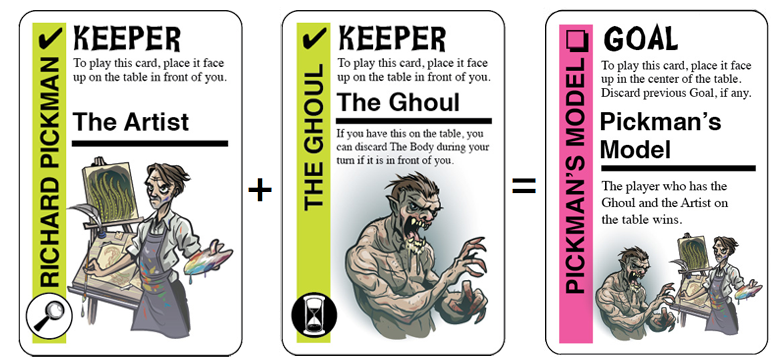
Richard Pickman is an artist with a curious muse and an astonishing knack for producing astonishingly lifelike images of horrifying monsters. We won\u2019t spoil the ending, but you can find the story online here!
A few weeks ago we talked about how certain Keepers are identified as Investigators. This reflects the idea that they are the kind of people who get caught up in trouble in Lovecraft’s stories, and lets us get more mileage out of them in our goals. The Artist is a direct reference to “Pickman’s Model.” But he can also undergo a Metamorphosis and be part of “The Shadow Over Innsmouth” goal; he take a trip to the Sanitarium for “Checking In”; he can team up with other Investigators to try to hold the Inevitable Doom at bay; and more. In this way we capture the flavor of the stories without being entirely locked into specific stories.
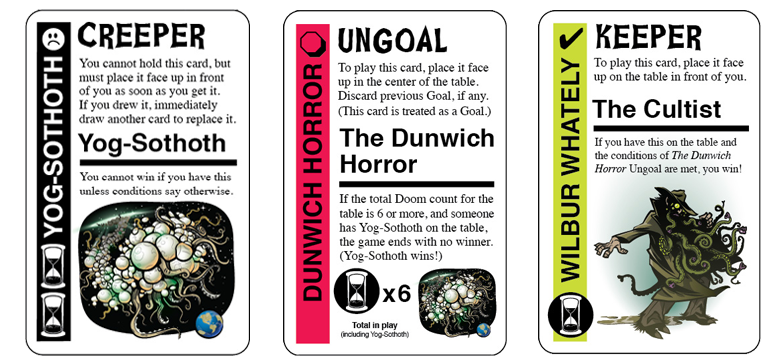
Ungoals are an important part of the genre and The Dunwich Horror is an excellent story, so it seemed like a good choice to wrap things up. Ungoals represent the lurking threat that the Great Old Ones will return to throw the world into chaos and terror. The Dunwich Horror is a special case, because Wilbur Whately wants Yog-Sothoth to return… so if you have the Cultist on the table, you actually override the normal rules and win if the Dunwich Horror comes to pass. And, of course, any play can win with an Ungoal if they have the Secret Cultist Surprise hidden away!
This is our last week of Guess That Goal. Thanks for following along, and get ready to delve into the maddening world of Cthulhu Fluxx… if you dare!